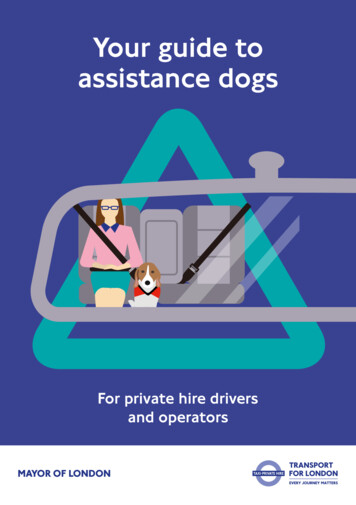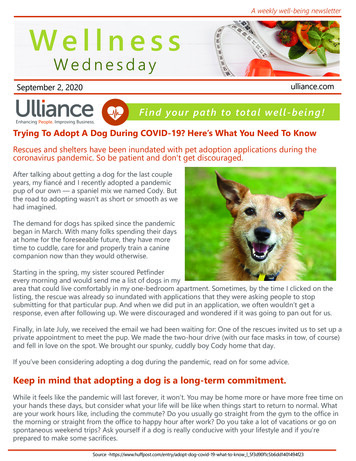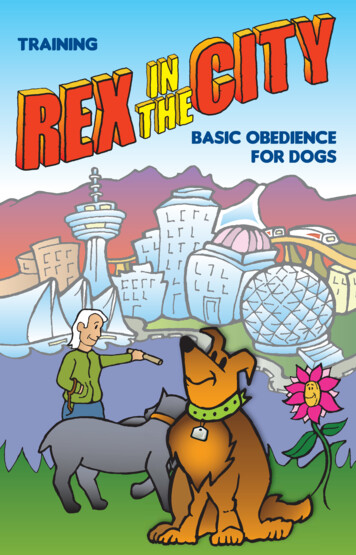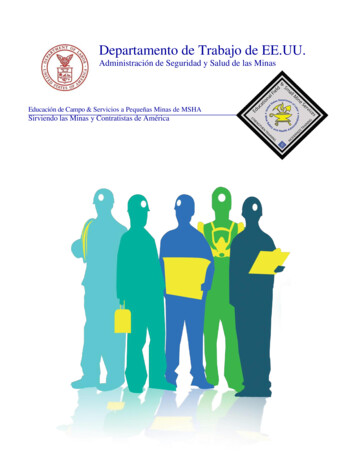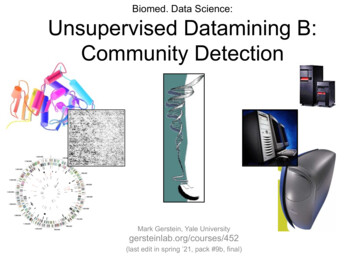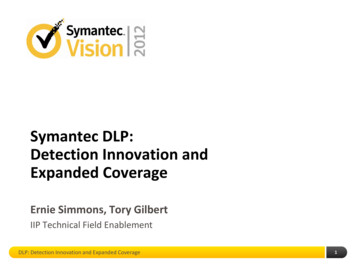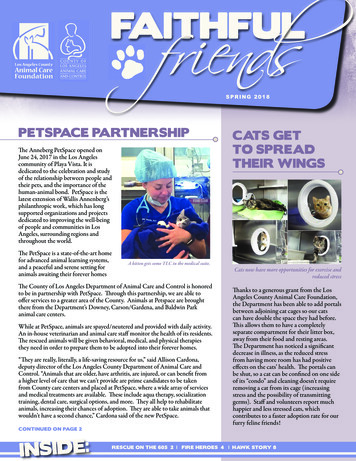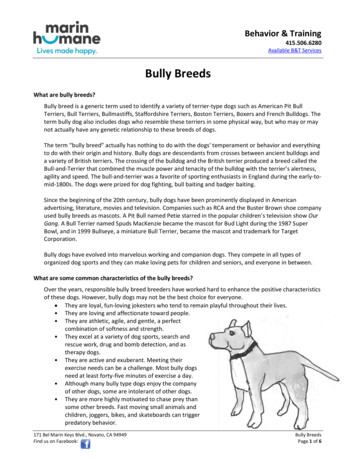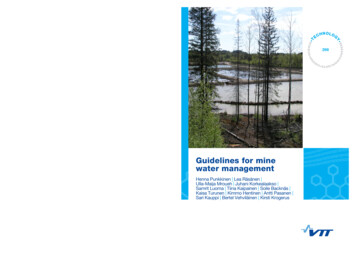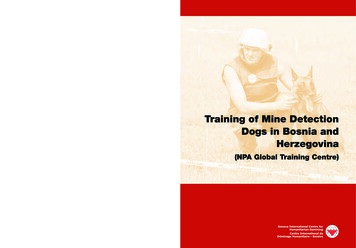
Transcription
Training of Mine Detection Dogs in Bosnia and Herzegovina(NPA Global Training Centre)Geneva International Centre for Humanitarian Demining7bis, avenue de la PaixP.O. Box 1300CH - 1211 Geneva 1SwitzerlandTel. (41 22) 906 16 60, Fax (41 22) 906 16 90www.gichd.chTraining of Mine DetectionDogs in Bosnia andHerzegovina(NPA Global Training Centre)
iTraining of Mine Detection Dogsin Bosnia and Herzegovina(NPA Global Training Centre)
iiThe Geneva International Centre for Humanitarian Demining (GICHD) supports the efforts ofthe international community in reducing the impact of mines and unexploded ordnance(UXO). The Centre provides operational assistance, is active in research and supports theimplementation of the Anti-Personnel Mine Ban Convention.For further information please contact:Geneva International Centre for Humanitarian Demining7bis, avenue de la PaixP.O. Box 1300CH-1211 Geneva 1SwitzerlandTel. (41 22) 906 16 60Fax (41 22) 906 16 90www.gichd.chinfo@gichd.chTraining of Mine Detection Dogs in Bosnia and Herzegovina (NPA Global Training Centre), GICHD,Geneva, December 2004.This project was managed by Håvard Bach, Head of Operational Methods Section(h.bach@gichd.ch).ISBN 2-88487-034-2 Geneva International Centre for Humanitarian DeminingThe views expressed in this publication are those of the authors. The designations employed andthe presentation of the material in this publication do not imply the expression of any opinionwhatsoever on the part of the GICHD concerning the legal status of any country, territory or area,or of its authorities or armed groups, or concerning the delimitation of its frontiers or boundaries.
iiiContentsForeword1IntroductionNPA GTC MDD training definitionStructure of the book346SECTION I. GENERAL ACTIVITIESChapter 1. NPA GTC MDD training process and use of rewardsNPA GTC MDD training processUse of rewards889SECTION II. BREEDING PROGRAMMEChapter 2. MDD breeding programmeBreeding programme objectivesDevelopmental stages and corresponding handling agendaPuppy assessment processNPA GTC evaluation of puppies1414152022SECTION III. PUPPY PROGRAMMEChapter 3. Puppy programmePuppy programme activities2626Chapter 4. Socialisation, interaction and environmental trainingSocialisation trainingInteraction trainingEnvironmental training28282929Chapter 5. Drive and motivation trainingLeather ragKong toyActivity and passivity sessionsChapter 6. Off-ground pressure-search training3232333339Chapter 7. Track trainingBasic track trainingAdvanced track training414143
ivChapter 8. Long-leashed MDD trainingIntroductionDirection trainingOn-ground pressure-search training for long-leashed MDDsIntegration of direction and pressure-searchReward systemChapter 9. Short-leashed MDD trainingProcedureRewarding techniques464647485053545456Chapter 10. On-ground pressure-search trainingProcedure5757Chapter 11. Carousel trainingPreparation and maintenance of the carouselCarousel training methodologyProcedures in rewarding in carousel exercises60616365Chapter 12. Internal assessment process, testing and policyRequirements for trackingRequirements for interactionRequirements for carousel searchingPolicy6767697071SECTION IV. MDD TRAINING PROGRAMMEChapter 13. Imprint trainingCarouselIndoor sandboxesTraining methodologyTraining fieldsChapter 14. Maintenance and developmental trainingPhysical stamina and endurance trainingMDD maintenance and development training7474757677797980Chapter 15. Transfer preparationRetired dogs8282Chapter 16. NPA Bosnia MDD handlerSelection criteriaTraining philosophyNPA MDD Bosnia handler training courseIssues related to matching a handler to a dogHandlers of short-leashed MDDsHandlers of long-leashed MDDs83838384858688Chapter 17. NPA Bosnia MDD trainerKey skills of trainersMDD trainer course919192Annexes1. NPA Bosnia’s MDD standing operating procedures2. Climatic and environmental conditions in Bosnia andHerzegovina3. Overview of the NPA Bosnia MDD Project9399100
v4. NPA Bosnia MDD Project testing procedures5. NPA MDD GTC training areas and kennel facilities102105Bibliography109Glossary of acronyms111Photo creditsCover photo: Mary KellyFigures 26, 46, 48-52 and 57 Damir Atikovic (Communication Officer, NPA MAP in BiH); 2-10,14-21, 23, 53, 63, Annex 1:1b, Annex 2: 1a-b, Annex 5: 3,4 NPA; all other photos Mary Kelly.
viAcknowledgementsThe Geneva International Centre for Humanitarian Demining (GICHD) would like toacknowledge all of the people who generously made time to share their views andexperiences during the study period. In particular, thanks go to the staff of NorwegianPeople’s Aid, who have all been very helpful and who demonstrated great hospitality andopenness throughout the project. The base managers and their staff deserve a specialmention for all their support and hospitality to the project. In addition, individual thanksare due to Kenan Muftic (MDD Co-coordinator), Håkon Ovland (MDD TrainingCo-coordinator), Tom Fossdal (Consultant), Nedim Fejzi (MDD Senior trainer), Marija Beze(MDD trainer), Livadiæ Elvir (MDD Team Leader), Bajriæ Midhat (MDD trainer), and MujagicElvir (MDD handler), all of whom have provided valuable input.Production of this document for the GICHD was managed by Håvard Bach and led by MaryKelly. Editing was by Jack Glattbach, Ian G. McLean and Rebecca Sargisson. Layout was byFrançoise Jaffré.
1ForewordThe Geneva International Centre for Humanitarian Demining (GICHD) launcheda study into mine dog detection in 1999. The study later evolved into a seriesof interrelated mine dog detection activities and research projects and thedevelopment of international mine action standards for mine dog detection. One ofthe key components of this study was an examination of mine detection dog (MDD)training methodology.The training of MDDs is a complex process, often using many different methods,and accompanied by an equally varied range of opinions and training techniquesfrom one organisation to the next. Until now, detailed documentation of MDD traininghas not been available to the general MDD community.This case study describes the MDD training programme used by Norwegian People’sAid (NPA) in its Global Training Centre (GTC) in Bosnia and Herzegovina. It is nota training manual, its aim is to promote the dissemination of information aboutsuccessful programmes to the larger MDD community and to encourage evolutionof methodologies by providing an example of one particularly successful methodamong the many MDD training programmes.The study had been requested by the United Nations Mine Action Service (UNMAS),but should also be of interest to the United Nations Development Programme (UNDP)and the United Nations Office of Project Services (UNOPS), as well as tonon-governmental organisations, national mine action programmes and commercialcompanies training and using MDDs.The GICHD would like to thank the United Kingdom Department for InternationalDevelopment for funding the project.Ambassador Stephan NellenDirectorGeneva International Centre forHumanitarian Demining
3IntroductionThis book provides an examination and a descriptive account of themethodologies used by Norwegian People’s Aid (NPA) at its Global TrainingCentre (GTC) in Bosnia and Herzegovina (Bosnia) for training mine detectiondogs (MDDs). In the following material, the phrase training methodologies is used todescribe the methods implemented in the training of both the dog and the handler.The methodologies and techniques described are constantly undergoingmodifications with the aim of improving the training system.It is generally acknowledged that styles of dog training vary and there are strongdifferences of opinion and belief among the members of the many dog-trainingcommunities (GICHD, 2003). There is no doubt that dog training is a complex processand can be undertaken successfully in a variety of different ways. A description ofone such system is provided here.NPA is one of the few non-governmental organisations (NGOs) that uses MDDs.NPA has gained competence during operational experience in many countries andregions, including Angola, Bosnia, Cambodia, Croatia, Kosovo and Mozambique. Itwas NPA’s desire to establish a standardised set of guidelines for the training ofMDDs. A uniform and familiar system among all NPA MDD programmes has led tothe development of a central MDD academy, the Global Training Centre, to supplyall NPA centres with dogs. As of 2004, NPA implemented the Global Training Centrefor MDDs and established an in-house breeding programme that are independentof the Regional Mine Action Programme.The training facility operated by NPA GTC in Bosnia (henceforth referred to as “theSchool”) has achieved a high standard, and it is the training system operated inBosnia that NPA chose as its standard for all programmes. This study provides adescription of that programme and includes analysis and justification of each stageof the training process.It is expected that the information describing the training model will be of use toother training centres for comparative purposes, with the aim of encouraging thetransfer of knowledge and experience throughout the MDD training community.
4Training of Mine Detection Dogs in Bosnia and HerzegovinaNPA GTC MDD training definitionNPA defines an MDD as a dog trained to detect target substances, specifically, mines,certain types and quantities of explosives, unexploded ordnance (UXO) and fragmentsof mines and UXO, above and below the surface of the ground.The quality of work and successful deployment of the School’s MDDs in mine clearanceoperations are based on intensive training, testing and analysis performed on a strictand continuous basis. As a result, the capacity, ability and accuracy of MDDs deployedin operational work can be predicted. The psychophysical characteristics of the dogs,a modern and inventive imprinting methodology, and an intense physical-endurancetraining programme are key elements of the training style. Health care and hygiene,medical follow-up and specialised dietary needs for each dog are also emphasised.PrinciplesFour key principles underpin the training of MDDs at the School:¾ emphasis on hunting behaviour;¾ pressure-search;¾ high level of difficulty in detection training; and¾ unpredictability.Principle One: HUNTINGThe dog’s natural hunting instinct is stimulated and developed. Hunting isincorporated into the training model through exercises aimed at building up thedog’s motivation to search. The key objective is to ensure that the dog is highlymotivated to perform all job activities.Principle Two: PRESSURE-SEARCHA dog exhibiting pressure-search has its nose constantly flush with the surface ofthe area being searched and is completely focused in the search so that concentrationis rarely broken. The key objective is to ensure that the dog is sniffing as close to theground surface as possible, giving the highest probability of detection success. Thisstyle of search is accomplished by training the dog to detect micro-sized pieces ofkong (the rubber device used to reward the dog during hunting training), whichcan only be detected if the dog’s nose passes very close by.Principle Three: MAXIMISING THE DIFFICULTY OF THE DETECTION TASKEven early in training, the dog is never given easy detection tasks. The dog’s initialsensitivity is measured using a training apparatus called the carousel (see Chapter 11).Once the dog is successfully detecting a difficult target, a training process designedto increase sensitivity further is introduced.The dog is initially presented with a target at the most difficult level, and then thedifficulty is progressively reduced (odour availability is increased) until the dogfinally detects the target, thus establishing the dog’s “detection sensitivity threshold”.This threshold is the most difficult level of a substance that the dog is able to detect.Once this threshold has been determined, the difficulty is gradually increased toimprove sensitivity. Training dogs to detect difficult targets at all times maintainsthe effort the dog must exert during the search.
IntroductionPrinciple Four: UNPREDICTABILITYEverything should be unpredictable for the dog. Rewards should not appear reliably,training should occur in different places, the type of the next target should not bepredicted by the current target, and so on. The dog constantly encounters unexpectedstimuli. In effect, all aspects of the training experience are randomised so that theposition of targets cannot be predicted. For example, training areas are rotated sothat the detection of the target cannot be based on memory.TermsThe following terms used in this document are defined as follows:¾ Maintenance training: The daily training used to maintain the level ofperformance of an accredited MDD unit (an MDD and its handler). This trainingincludes pressure-search exercises using micro-sized pieces of kong.¾ Developmental training: A form of training designed to improve the alreadypresent and established skills of MDDs. For instance, the detection sensitivityof an MDD is developed by increasing the level of detection difficulty of atarget.¾ Retraining: Training an operational MDD to learn a new skill. For example,teaching a short-leashed MDD to become a long-leashed MDD.¾ Refresher training: The training that occurs after the MDD has experienced aperiod of downtime longer than three days. Downtime may be due to vacations,illness or seasonal and environmental factors that last more than three days.Training philosophyTraining is adapted to the individual dog with the aim of promoting and improvingeach MDD’s performance by meeting its individual needs. The dog must progress atits own speed with the pace of training dictated in accordance with the dog’s progress.If the training pace were to continue irrespective of the dog’s progress, then thedog’s training performance could regress and the dog may lose motivation or refuseto do the activity. The key principle is maintenance of a high motivation to performall activities in the mine detection role.To maintain a standard of success, and to improve that standard, an open-mindedand receptive attitude towards new and alternate ideas, techniques and methodologiesis adopted. Since MDD training is a complex process, there are no quick fixes, andmany remedies can be found by looking to other sources. The exchange of knowledgeand experience is encouraged.Training of NPA GTC MDDs is a constant and long-term process for all those involvedin the MDD teams (trainers, handlers and the dogs). The importance of establishinga firm teamwork foundation between the MDD unit and all members of the MDDteams is stressed. The attitude emphasised during all training of MDDs is that youwill only get out what you put in. Therefore, it is the handlers and trainers that mustprovide for and meet all of the dogs’ needs. The handlers and trainers must investan enormous amount of their time and patience for the training of the dog to besuccessful.The general training programme proceeds in a sequence. The trainer must ensurethat the dog is capable of performing all steps in each stage prior to moving on tothe next. All steps must be performed in an interconnected and continuous manner.5
6Training of Mine Detection Dogs in Bosnia and HerzegovinaWithin each step of the general framework, the School strives for simplicity notcomplexity when training for a specific behaviour: a simple approach reduces theroom for training error and minimises confusion for the dog. A segment-by-segmentmethod is used to train complex behaviours; this focuses on the specific details ofthe behaviour pattern independently of other components. Only when the MDDunit is able to perform each step successfully will all of the steps be integrated toform the desired behavioural pattern.Structure of the bookThe book reflects the “training timeline” of a dog’s life in the NPA MDD GTC trainingmodel, beginning with the selection of breeding parents and ending with preparationfor transfer from the School. The book is divided into four sections: General activities,Breeding Programme, Puppy Programme, and Mine Detection Dog Training Programme.Section I, General activities, provides a general framework of the NPA MDD GTCtraining process and describes the principles of the reward system and the use ofrewards within the training process.The following sections (II to IV) reflect the training timeline and the associatedtraining techniques and activities. The timeline is linked to key events in the life ofthe dog, and the timing of events depends on training progress with the dog.Furthermore, many training activities overlap in time. Within each section, specifictopics are addressed in separate chapters.Each chapter includes a “troubleshooting” section. These sections propose techniquesfor solving some of the common challenges encountered during training of NPAGTC MDDs. The process involved in correcting a challenge encountered consists offirst identifying the problem, then analysing the problem to determine why it isoccurring, then initiating a training regime to best confront and correct the problemfor that individual dog. Due to the numerous variables involved in any trainingprogramme, an infinite number of issues can influence the dog’s performance. Suchvariables include the dog’s personality, temperament, health, previous training, thehandler’s skill and experience, the training environment, the weather and the season.
7Section IGeneral activitiesSection I describes the framework of the NPA GTC MDD training process and givesbasic details on the use of rewards. The issues discussed in Chapter 1 — the use ofrewards — must be understood by trainers and handlers before working with anydog as they apply throughout the training model, and consistency in their applicationis critical to a successful training outcome. Issues covered include how to determinewhich reward category is appropriate for a dog, and different procedures andtechniques for using rewards. As set out in the various chapters, the choice of thereward and the manner of its allocation will depend on the dog and the trainingactivity.
8Training of Mine Detection Dogs in Bosnia and HerzegovinaChapter 1NPA GTC MDDtraining processand use of rewardsNPA GTC MDD training processThe following describes the overall general framework of the NPA GTC MDD trainingmodel. This framework illustrates the most common route and a very generaltimescale that a dog experiences during its training with NPA GTC (Figure 1). Animportant component of this framework is flexibility, allowing the trainer to modify,adjust and fine-tune the details of training each dog.Summary of the training modelBreeding programme: 0 to 7 weeksActivities:¾ handling;¾ separate feeding;¾ environmental and socialisation training;¾ assessment;¾ transfer to puppy trainers when 7 to 8 weeks old.Puppy programme: 7 weeks to 18 monthsActivities:¾ socialisation training;¾ environmental training;¾ drive and motivational training;¾ off-ground pressure-search training;¾ tracking training;¾ search pattern (short- or long-leashed MDD) training;¾ on-ground pressure-search training;¾ carousel training;¾ internal assessment.
9Figure 1. General training processMDD Training Programme: 18 months Activities:¾ imprint training: carousel training indoor sandbox training fields;¾ maintenance and development training;¾ endurance training;¾ transfer preparation training.Use of rewardsRewards used for MDDs consist of a combination of vocal and physical praise, andeither food rewards or sessions of play-fighting over a kong toy. The rewardingnature of these things is originally established during the Puppy Programme(Chapter 3) during activity and passivity exercises (Chapter 5). The specific allocationof rewards depends on the context. An important component of the context is thedog itself; in particular, its motivation.Theoretical projections of motivation are shown in Figure 2. Here, the y axisrepresents increasing motivation to search, where motivation results from aninteraction between the internal state of the dog and external stimuli provided bythe trainer. The main internal factor is the hunting drive, which the trainermanipulates in order to optimise motivation to search. Other contributors tomotivation are interest in play and willingness to please the trainer. The relativecontribution of each of these factors will vary between dogs. Motivation is primarilyexpressed or measured as excitement. Thus the dog exhibits increasing levels ofexcitement that the trainer adjusts in order to manipulate motivation. The x axis
10Training of Mine Detection Dogs in Bosnia and Herzegovinarepresents time, and could be as little as a 30-minute training session or as much asseveral weeks, in which case the graph is portraying motivation levels across someor many training sessions.Figure 2. Motivation projections for an MDD through timeThe dark green dotted line is the optimal motivational response and the traineraims to keep motivation as close to that line as possible. An overly-excitable dog(blue line) needs to be calmed, whereas an uninterested dog (yellow line) needs tohave its motivation raised. The red line portrays a dog that is initially well-motivatedbut which loses interest in the task too quickly. The green solid line is a practicalexample of a dog for which motivation is being adjusted optimally. Trainers adjustmotivation by stimulating excitement using a play-fighting toy. The intensity of playfighting is adjusted up or down the scale in Figure 3 depending on the currentmotivation (or excitement) exhibited by the dog. Play-fighting is itself a reward. Adog that is too excited (high-motivational response) needs to be calmed and thetrainer aims to shift the motivation to the left of the scale. A disinterested dog (lowmotivational response) needs to have its motivation raised and the trainer aims toshift the motivation to the right of the scale. Adjustments to motivation can occurwithin a fairly short period, although within one training session the trainer is likelyto work to a fairly narrow range on the scale.Figure 3. Intensity adjustments in allocation of reward
NPA GTC MDD training process and use of rewardsFor the majority of dogs, play-fighting between the trainer and the dog involves akong with an attached rope. As the aim is to establish the kong as a reward withwhich to reinforce other behaviour, the trainer eventually allows the dog to win thekong. If motivation (excitement) is too high, the trainer may not allow the dog towin the kong on every occasion or could use a kong toy without a rope attached,preventing play-fighting.Play-fighting consists of the dog jumping, growling and chasing after or pulling thekong away from the trainer. The dog must never be allowed to cross over fromplay-fighting to aggressive fighting, indicated by the dog biting or being otherwiseaggressive towards the trainer. Play-fighting involves displays of tail wagging,absence of hunched shoulders and the absence of a “ruff” (the erected fur from thebase of the neck covering the shoulders to the base of the tail), and is easilydistinguished from aggressive fighting. However, the vocal displays used duringboth play and aggressive fighting (growls, barks) can sound essentially the same.Food has been used in the past as the main form of reward for some dogs, but isnow rarely used. Although food rewards elicit strong responses relative to the kong,these responses are pacifying and short lived. Food is only used with dogs thatbecome uncontrollably excited when the kong is used.Reward patternsWhen introducing any new desired learning response, a continuous reward schedule(CRS) is used; i.e. the dog is rewarded on every occasion it exhibits the desiredbehaviour or response (Fjellanger, 2003). Once the behaviour is established, thereward rate is progressively reduced (to become an intermittent reward schedule— IRS), with an increasingly smaller and more randomised proportion of correctresponses being rewarded. If a CRS was continued after a specific behaviour hadbeen established, the dog learns to expect the reward and the response frequentlybecomes “sloppy”. This process applies standard principles of the psychology oflearning (more detail in Fjellanger, op. cit.) and achieves higher levels of motivationand a more reliable response pattern than will CRSs.TechniquesIdeally, rewards will appear spontaneously for the dog and will not be linked directlyto the trainer. The reward is kept hidden during exercises, often by being heldunder the left armpit. When the dog expresses a desired behaviour, such as sniffingat a mine, the trainer maintains the attention of the dog on the mine and tosses thekong near that location. For the dog, the reward appears from nowhere and is linkedto the mine rather than to the trainer.Training for detection of mines will sometimes occur when the trainer does notknow where the mines are located. Under those circumstances, the trainer mustnever reward the dog. If an indication is given, the trainer cannot know if there is amine, or if the indication is false, for example because the dog is indicating aninteresting odour such as a rabbit. Rewarding a false indication will lead rapidly toan increase in false indications because the behaviour of indicating will have beenstrengthened in the absence of the odour of the target. In other words, indicatinghas been encouraged, even when there is no target present. This will lead to indicationsof all interesting odours, or the dog may even begin to offer indications in order tomanipulate the trainer into providing the reward.11
12Training of Mine Detection Dogs in Bosnia and HerzegovinaDogs must be trained in a variety of areas and should not be trained repeatedly inthe same location. Regular training at one location can lead to gambling, where thedog knows approximately where the mines are and indicates the general vicinity ofthe mine without doing a proper search.Dogs must be trained regularly in areas not containing mines. As training progresses,the proportion of time spent working in “no-mine” areas should increase, becausethe dog must learn that find rates for an operational dog will be low.Operational dogs working in minefields receive no rewards (unless the handler cansee that a mine or fragment is present at an indication location). This issue is addressedusing the IRS during training. As a result of an IRS, dogs learn that finding an objectdoes not necessarily lead to a reward. Thus when they are operational, dogs haveno expectation that any particular indication will result in a reward. Their experienceis that rewards appear on a small proportion of indications. Once the dog isestablished on an IRS, the handler can maintain motivation by introducing targets(either in the minefield or in an adjacent training area) and reward indications onthose targets.Once a desired behaviour has been established, the allocation of rewards becomesstrict. The handler must keep the kong toy hidden during training exercises to avoidtraining the MDD to focus on the toy instead of the task at hand. The School regularlyuses helper handlers (assistants) to administer the rewards, especially during longleashed and carousel training (Chapters 8 and 11). The kong toy is spontaneouslyplaced in the precise indication location. This form of reward placement trains intensefocus by the dog towards the place of detection and not on the handler.
13Section IIBreeding programmeSection II describes the main activities and common issues encountered in the BreedingProgramme. Topics covered include main objectives, responsibilities, and the criticaldevelopmental stages and handling requirements for the developing pups.TimelineBreeding programme: 0 to 7 weeksActivities:¾ handling;¾ separate feeding;¾ socialisation training;¾ environmental training;¾ assessment;¾ transfer to puppy programme when 7 to 8 weeks old.
14Training of Mine Detection Dogs in Bosnia and HerzegovinaChapter 2MDD breedingprogrammeTraining for MDDs should begin as early in the dogs’ life as possible. Thereare critical stages in the dog’s life that strongly affect their learning andbehaviour, and many of these occur in the first weeks (van Wyk and LeRoux, 2003). Not every dog can be trained for mine detection operations. Thedog must naturally possess certain traits and characteristics which can bedeveloped during training. The process of selecting and training dogs withpotential to be MDDs is extremely difficult and involves an ability to foreseepotential in the dog (Matre, 2003).The breeding programme consists of in-house breeding of MDDs and aims toprepare all the puppies for the puppy programme. Occasionally, puppies areselected at 6 to 7 weeks of age from litters recognised by accredited breederassociations.Breeding programme objectives¾ Health: Health of the puppies is assured through constant monitoring of thelitter and the mother, maintaining a hygienic environment and ensuring thatnutritional needs are met from the mother’s milk.¾ Behaviour: The puppies are encouraged to be as social, active, rambunctiousand fearless as possible, through gently and cautiously introducing and exposingthem to a variety of stimuli and providing many opportunities for play andexploration.Choice of parentsBoth parents are to be of extremely good health and free of hip dysplasia or anyother genetic disorder or malady. It is preferable that both parents be fully trainedMDDs. The preferred behavioural attributes of both parents are:¾ high motivational drives with an emphasis on hunting behaviour and playfighting;¾ extremely good environmental skills (highly adaptable);
MDD breeding programme¾ active and outgoing;¾ stable personality.Care of the damThe dam is maintained on her regular daily routine of MDD training throughout theentire gestation period. The dam resides at the kenn
a training manual, its aim is to promote the dissemination of information about . It is generally acknowledged that styles of dog training vary and there are strong differences of opinion and belief among the members of the many dog-training communities (GICHD, 2003). There is no doub

